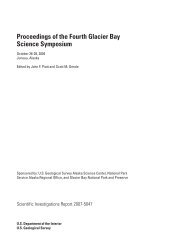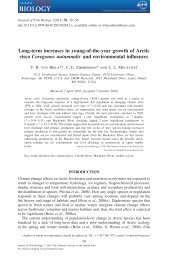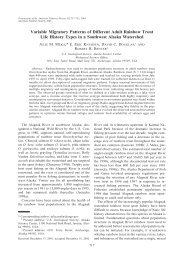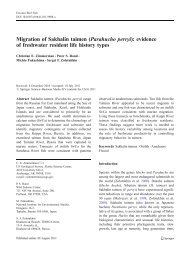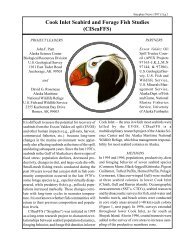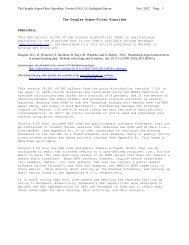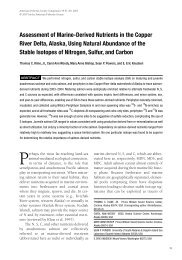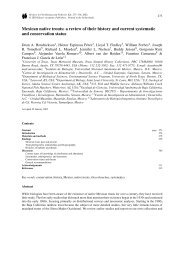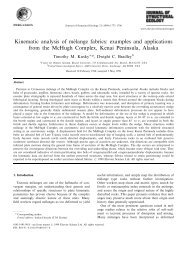Aniakchak Sockeye Salmon Investigations - Alaska Science Center
Aniakchak Sockeye Salmon Investigations - Alaska Science Center
Aniakchak Sockeye Salmon Investigations - Alaska Science Center
You also want an ePaper? Increase the reach of your titles
YUMPU automatically turns print PDFs into web optimized ePapers that Google loves.
<strong>Aniakchak</strong> <strong>Sockeye</strong> <strong>Salmon</strong> <strong>Investigations</strong>by Troy R. Hamon, Scott A. Pavey,Joe L. Miller, and Jennifer L. NielsenIntroduction<strong>Aniakchak</strong> National Monument andPreserve provides unusual and dramaticlandscapes shaped by numerous volcaniceruptions, a massive flood, enormous landslides,and ongoing geological change. Thefocal point of the monument is <strong>Aniakchak</strong>Caldera, a restless volcano that embodiesthe instability of the <strong>Alaska</strong> Peninsula. Thisgeological instability creates a dynamic andchallenging environment for the biologicaloccupants of <strong>Aniakchak</strong> and unparalleledopportunities for scientists to measure theadaptability of organisms and ecosystemsto change.The sockeye salmon (Oncorhynchusnerka) is one member of the <strong>Aniakchak</strong>ecosystem that has managed to adapt togeologic upheaval and is now thriving inthe park. Aside from just surviving in theharsh environment, these salmon are alsonoteworthy for providing essential marinederivednutrients to plants and animals andas a source of food for historic and presentday people in the region.With this backdrop, researchers fromthe National Park Service (NPS), U.S.Geological Survey (USGS), and Universityof <strong>Alaska</strong> Anchorage have begun to studyhow the volcanic landscape of <strong>Aniakchak</strong>has contributed to the local adaptationsand relatedness of its different sockeyeinhabitants. More specifically, the goal ofthe research is to measure the evolution ofshape and genetic similarity of sockeyepopulations across a diverse range ofhabitats that reflect the violent history ofthe monument—Surprise Lake, located inthe semi-dormant <strong>Aniakchak</strong> Caldera;<strong>Aniakchak</strong> River, a high gradient river flowingthrough the denuded route of a massiveancient flood; and Albert Johnson Creek, asinuous, low-gradient creek draining intothe <strong>Aniakchak</strong> River. By understanding therole of extreme habitat variation in shapingthe ecology and evolution of sockeye, thisproject will help NPS managers identify therole of geological events in creating speciesdiversity and promote management actionsthat protect ecosystem functions andresource users.History<strong>Aniakchak</strong> Calderawas formed 3,500 yearsago by a tremendousvolcanic eruption onthe <strong>Alaska</strong> Peninsula(Figure 1).More than 12cubic miles(50 km 3 ) ofmaterial wereextruded (Millerand Smith 1987,Riehle et al. 1987,Begét et al. 1992) causingmassive landslides,debris flows, ash deposits,and a tsunami in BristolBay. Following this eruption,the caldera filled with water, forming alarge lake similar to Crater Lake in Oregon(McGimsey et al. 1994). Between 3,400 and500 years ago, the caldera wall ruptured andthe lake (now known as Surprise Lake)drained, causing a catastrophic flood thatscoured the valley below (Figure 2), depositingcar-sized boulders in the floodplainFigure 1. Map showing location of <strong>Aniakchak</strong>National Monument and Preserve on the<strong>Alaska</strong> Peninsula. Letters A, B, and Ccorrespond to sockeye salmon spawningareas in Surprise Lake, <strong>Aniakchak</strong> River outlet,and Albert Johnson Creek, respectively.Opposite Page: Surprise Lake surrounded bythe <strong>Aniakchak</strong> Caldera.National Park Service photograph35
<strong>Aniakchak</strong> <strong>Sockeye</strong> <strong>Salmon</strong> <strong>Investigations</strong>National Park Service photographIn 1931, <strong>Aniakchak</strong> erupted again,covering the caldera with ash anddebris, wiping out plants in thecaldera and decimating aquatic lifein Surprise LakeFigure 2. <strong>Aniakchak</strong> River flowing out ofthe caldera at “The Gates.” When theancient caldera ruptured, a massive floodensued creating the present day <strong>Aniakchak</strong>River and a new migratory corridor for fishcolonizing Surprise Lake.Photograph © Troy Hamon36(Waythomas et al. 1996). Where the calderawall ruptured, a drainage was formedconnecting Surprise Lake with the Gulfof <strong>Alaska</strong> (Waythomas et al. 1996). Thisdrainage, now known as the <strong>Aniakchak</strong>River, provided new habitat for fish speciesand a colonization route to Surprise Lake.In 1931, <strong>Aniakchak</strong> erupted again, coveringthe caldera with ash and debris, wipingout plants in the caldera and decimatingaquatic life in Surprise Lake (Jaggar 1932).This event occurred only nine years after thecaldera was first described in 1922 (Smith1925, Hubbard 1931), providing rare photodocumentationof a completely naturalecosystem before and after a major eruption.Continuing volcanism and unique geologiclandforms have contributed to <strong>Aniakchak</strong>’sdesignations as a National Natural Landmark(Bureau of Land Management 1970),National Monument and Preserve, andWild River (U.S. Public Law 96-487, 1980).Figure 3. An iron spring flowing into the western end of Surprise Lake. The western andsouthern beaches of Surprise Lake have numerous springs but are unfit for sockeye salmonspawners because of anoxic conditions.
Colonization by <strong>Salmon</strong>idsThe life history of sockeye salmon ishighly variable among individual locations,but some general rules apply. After emergingfrom eggs buried in gravel, juvenilesockeye salmon typically rear in largefreshwater lakes for one or two years beforegoing to sea. Some populations do not uselakes but instead rely on river habitat forjuvenile rearing. After rearing in freshwater,sockeye migrate to the sea as smolts. Allsockeye spend one to three years at seaattaining most of their adult mass by feedingon rich marine food resources. Asadults they return to their natal freshwaterto spawn and restart the cycle.<strong>Sockeye</strong> are anadromous, spawning infreshwater after migrating from the sea.This means that freshwater spawning habitatis essential for perpetuating their lifehistory. The availability of new freshwaterhabitat following volcanism, glaciation, orother geological events provides opportunitiesfor fish to colonize new areas andbecome locally adapted to their habitat.Colonizing a new habitat also provides amechanism for creating new populationsthat are physically and genetically divergentfrom ancestral populations—key steps inthe creation of species diversity and theprocess of evolution.After the catastrophic <strong>Aniakchak</strong> flood,the connection between Surprise Lake andthe ocean provided new freshwater habitatfor anadromous species. <strong>Sockeye</strong> salmonand Dolly Varden (Salvelinus malma)subsequently colonized the lake andriver, establishing spawning populations(Mahoney and Sonnevil 1991). The naturalhistory of the populations of sockeyesalmon in <strong>Aniakchak</strong> Caldera is unique intwo aspects: 1) they are some of the mostrecently established natural populationsknown in southwest <strong>Alaska</strong>, and perhapsthe most recent, and 2) they either persistedthrough the 1931 eruption, or theyrecolonized quickly following the eruption.Most other lake systems in southwest<strong>Alaska</strong> have had viable habitat for around10,000 years while Surprise Lake has onlybeen accessible for about 1,800 years. Theeruption of 1931 likely wiped out mostof the salmon run for a couple of years.Fish returning later may have found theenvironment suitable once again, or thepresent populations may be less than 70years old. Because sockeye salmon generallyhave a five year life cycle, the currentpopulation in Surprise Lake has hadbetween 14 and 400 generations to becomeadapted to local habitats.Measuring Adaptationand Genetic SimilarityManagement decisions that protect boththe resource and resource users require adetailed understanding of focus species.Measurements of local adaptation (physicalcharacteristics such as body size orshape) and genetic similarity/divergenceare critical for establishing the presenceor absence of multiple populations and,subsequently, defining the scale at whichmanagement actions are applied. If twogroups of fish are clearly distinct both inphysical and genetic characteristics, theymay require independent managementconsideration.In this context, the NPS and USGSbegan a multi-year study to determine howFigure 4. Representative sockeye salmon beach spawners from Surprise Lake. The fish onthe left is a female (held by NPS employee Chistina Olson), and the right, a male (held byNPS employee Bill Hobbins).Figure 5. Diagrammatic representation of genetic similarity among Surprise Lake, <strong>Aniakchak</strong>River, and Albert Johnson Creek sockeye salmon. It appears that each group of salmon isgenetically different from the others; however, fish from the caldera (Surprise Lake and<strong>Aniakchak</strong> River) are more similar to one another than either is to fish from Albert JohnsonCreek. Black and Meshik Lakes represent two nearby sockeye populations outside of the<strong>Aniakchak</strong> River drainage.National Park Service photograph37
<strong>Aniakchak</strong> <strong>Sockeye</strong> <strong>Salmon</strong> <strong>Investigations</strong>Biologists sampling sockeye spawners with a seine in the outlet of the <strong>Aniakchak</strong> River.sockeye have adapted to the landscape of<strong>Aniakchak</strong> and to investigate genetic similarityamong fish in certain habitat types.The study had four main objectives. First,the entire <strong>Aniakchak</strong> River drainage was tobe searched to identify and cataloguespawning populations of sockeye salmon.Second, physical characteristics of habitatin use by sockeye were to be compared withcharacteristics of habitat not used by sockeye.Third, physical size and shape of sockeyewere to be compared among populations.Finally, genetic analyses were to beused to examine the similarity and potentialdivergence among populations.Extensive surveys both on the groundand by air confirmed the existence ofpopulations in Albert Johnson Creek, in<strong>Aniakchak</strong> River within the caldera, and inSurprise Lake. There were no sockeyepopulations in the rest of the mainstem of<strong>Aniakchak</strong> River, nor in any of the othertributaries. In the caldera, there were populationsof sockeye spawning along the lakebeaches where water feeds into the lakeUSGS <strong>Alaska</strong> <strong>Science</strong> <strong>Center</strong> photographfrom the caldera wall, but none along theopposite side of the lake where water drainsin from the main interior of the caldera.Most of the groundwater entering fromthat side is high in heavy metals and has nodissolved oxygen (Figure 3), consistent withthe known vulnerabilities of incubatingsockeye eggs; however, more than eight lakebeach populations were identified. Theaggregate number of spawners in any yearis probably less than 50,000 or as low as5,000, which is relatively small. The neighboringChignik River system (Chignik andBlack Lakes) usually has returns in excessof two million fish. As long as sockeyeremain abundant in the Chignik lakes andcommercial harvest effort remains focusedon Chignik Bay, the small run of SurpriseLake and <strong>Aniakchak</strong> River sockeye salmonis unlikely to suffer adverse fishing impacts.Comparisons of body depth revealedpatterns of divergence among the differentspawning populations. Overall, sockeyefrom Albert Johnson Creek and SurpriseLake (Figure 4) were deep bodied whilethose from the <strong>Aniakchak</strong> River were relativelyshallow. The shapes of the calderaspawners fit patterns observed elsewherein southwest <strong>Alaska</strong>, however the streamspawners from Albert Johnson Creek weresurprisingly deep-bodied. In other sockeyepopulations, where different habitat…Albert Johnson Creek fish, inhabiting a stream, are particularly deep-bodied, doesnot fit the pattern. It is not yet clear whether there is an alternative explanationdue to the different life history or migration difficulty experienced by these fish, orif the present explanation for body depth variation needs closer scrutiny.38
types are interconnected, body depthtends to be smallest in streams and greatestin lakes then rivers. It is not yet clearwhether the differences in body shape areexplained by adaptation to spawning habitator responses to other factors such asmigratory difficulty or life history variation.Nevertheless, we found that differenceswere consistent over several years, indicatinga stable and real pattern of divergencein body shape.Genetic sampling also confirms thesedifferences. All three populations aregenetically differentiated, suggesting reproductiveisolation among the groups (Figure5). Even the nearby Surprise Lake and<strong>Aniakchak</strong> River spawning populations inthe caldera appear to differ from eachother. These results suggest that even withthe relatively short time frame since colonizationof the caldera, substantial differencesin body depth and genetic markershave developed. The genetic analyses alsosuggest that caldera lake and river populations,as a group, are distinct from AlbertJohnson Creek.With additional data, these findings willhelp us understand the origins of colonizingsockeye salmon populations in the park.Additional work on both a small and a largescale will help us to determine how theseresults integrate with sockeye throughouttheir range, and may have implications forconservation and restoration of endangeredpopulations. At present, the populationsat <strong>Aniakchak</strong>, though relatively small,appear to be very healthy and representadaptations to a unique region.Transporting field gear down the <strong>Aniakchak</strong> River from Surprise Lake. Field work in<strong>Aniakchak</strong> can be difficult because of weather, remoteness, and challenging river conditions.USGS <strong>Alaska</strong> <strong>Science</strong> <strong>Center</strong> photographREFERENCESBegét, J.E., O.K. Mason, and P.M. Anderson. 1992.Age, extent and climatic significance of the 3400 BP<strong>Aniakchak</strong> tephra, western <strong>Alaska</strong>, USA.The Holocene 2: 51-56.Bureau of Land Management. 1970.Registration of <strong>Aniakchak</strong> Crater as a NaturalLandmark. Letter to Director of National Park Serviceon file in Anchorage offices of National Park Service.Hubbard, B.R. 1931. A world inside a mountain.National Geographic 60: 319-345.Jaggar, T.A. 1932. Aleutian eruptions 1930-32.The Volcano Letter 375: 1-4.Mahoney, B.A., and G.M. Sonnevil. 1991.Surprise Lake and <strong>Aniakchak</strong> River fishery investigation,<strong>Aniakchak</strong> National Monument and Preserve, <strong>Alaska</strong>,1987 and 1988 final report. U.S. Fish and WildlifeService. <strong>Alaska</strong> Fisheries Technical Report No. 12.McGimsey, R.G., C.F. Waythomas, and C.A. Neal. 1994.High stand and catastrophic draining of intracalderaSurprise Lake, <strong>Aniakchak</strong> Volcano, <strong>Alaska</strong>.In Geologic Studies in <strong>Alaska</strong> by the U. S. GeologicalSurvey during 1993, edited by A.B. Till and T.E. Moore.U. S. Geological Survey Bulletin 2107. 59-71.Miller, T.P., and R.L. Smith. 1987.Late Quaternary caldera-forming eruptions in theeastern Aleutian arc, <strong>Alaska</strong>. Geology 15: 434-438.Riehle, J.R., C.E. Meyer, T.A. Ager, D.S. Kaufman, and R.E.Ackerman. 1987. The <strong>Aniakchak</strong> tephra deposit,a late Holocene marker horizon in western <strong>Alaska</strong>.In Geologic Studies in <strong>Alaska</strong> by the U.S. GeologicalSurvey during 1986, edited by T.D. Hamilton and J.P.Galloway. U.S. Geological Survey Circular C 0998. 19-22.Smith, W.R. 1925. <strong>Aniakchak</strong> Crater, <strong>Alaska</strong> Peninsula.Shorter Contributions to General Geology 1923-1924:139-145.U.S. Public Law. 1980.<strong>Alaska</strong> National Interest Lands Conservation Act. 96-487.Waythomas, C.F., J.S. Walder, R.G. McGimsey, and C.A. Neal.1996. A catastrophic flood caused by drainage ofa caldera lake at <strong>Aniakchak</strong> Volcano, <strong>Alaska</strong>,and implications for volcanic hazards assessment.GSA Bulletin 108: 861-871.39




